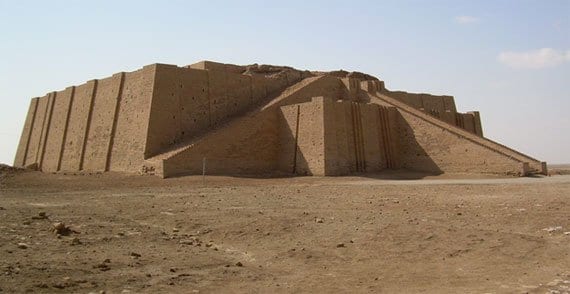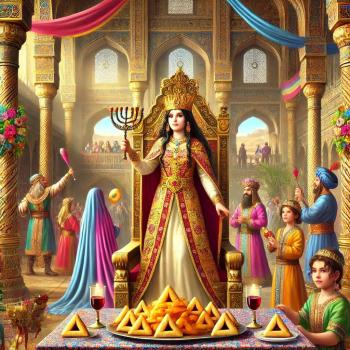 The ancients of Mesopotamia in city-states of the Middle East built ziggurats to worship their gods. These people were mostly Sumerians, Assyrians, Elamites, and Babylonians. These massive structures they built were pyramidally-shaped with four sides. They consisted of a series of stories successively lesser in width, often seven in all, that reached an apex plateau. A ramp usually ascended all four sides to reach a top, square-shaped plateau.
The ancients of Mesopotamia in city-states of the Middle East built ziggurats to worship their gods. These people were mostly Sumerians, Assyrians, Elamites, and Babylonians. These massive structures they built were pyramidally-shaped with four sides. They consisted of a series of stories successively lesser in width, often seven in all, that reached an apex plateau. A ramp usually ascended all four sides to reach a top, square-shaped plateau.
Herodotus–the so-called “father of history” who lived in the fifth century BCE–said a square-shaped building, that was considered a sacred shrine, rested on the top plateau of each ziggurat. That city’s worshippers believed their patron god descended on occasion to dwell in this “house.” A high priest might ascend the ramp on special occasions, in accordance with their religious calendar, to supposedly meet the god.
Then, of course, the ancient Egyptians had their stone-covered pyramids for religious reasons also. These were slightly different from ziggurats in that there was no ramp and no shrine on top. They might have an image of the face of a king merged with some animal’s body, such as a sphinx. These pyramids had a labyrinth of secret tunnels and rooms inside them. The Egyptians placed the mummified corpses of their kings in one of these rooms. Those kings believed that all of this building and ritual insured that their bodies would be resurrected in a future life.
The Mayans and Aztecs of Central America seem to have borrowed ideas for their pyramidally-shaped structures from those ancients of Mesopotamia and Egypt.
One of the best-preserved ziggurats in Mesopotamia is at the site of the ancient city of Ur, in southern Iraq. That is the city where the patriarch Abraham, then named Abram, first lived. He left his hometown in search of a land, a people, and a city which his God had promised him (Genesis 12.1-4; 15.18-21; Galatians 4.26; Hebrews 11.8-10, 16-19; cf. 12.22; 13.14; Revelation 3.12; 21–22). The above photo is of the ziggurat at Ur. It has been refurbished. None of the remaining ziggurat ruins in the Middle East have all of their original stories or levels. I think this one at Ur only has the first level.
The main purpose of the ziggurats was that the people believed they connected heaven and earth. The first ziggurat is believed to be the tower of Babel. The story about it is in the Bible, in Genesis 11. It tells about the whole earth having one language. The people journeyed to “the land of Shinar,” which was in central Iraq. They said, “Come, let us make bricks, and burn them thoroughly. . . . Come, let us build ourselves a city, and a tower with its top in the heavens, and let us make a name for ourselves” (vv. 3-4). God didn’t like the idea and therefore confused their language. They couldn’t understand each other. That caused them to stop their building project and scatter about the earth.
This effort to reach up to the heavens recalls a story about Jacob. Abraham’s grandson Jacob traveled to Haran in Syria. That’s where his grandfather Abraham had lived for a short time on his way from Ur, up the Euphrates River, to Haran and then down to the land of Canaan. Years later, Jacob was going to Haran to get a wife from his people.
We read, “Jacob left Beersheba and went toward Haran. He came to a certain place and stayed there for the night, because the sun had set. Taking one of the stones of the place, he put it under his head and lay down in that place. And he dreamed that there was a ladder set up on the earth the tope of it reaching to heaven; and the angels of God were ascending and descending on it. And the LORD stood beside him and said, ‘I am the LORD, the God of Abraham your father and the God of Isaac; the land on which you lie I will give to you and to your offspring; and your offspring shall be like the dust of the earth, and you shall spread abroad to the west and to the east and to the north and to the south; and all the families of the earth shall be blessed in you and in your offspring. Know that I am with you and will keep you wherever you go, . . .’ Then Jacob woke from his from his sleep and said, ‘Surely the LORD is in this place–and I did not know it!’ And he was afraid, and said, ‘How awesome is this place! This is none other than the house of God, and this is the gate of heaven.’
“So Jacob rose early in the morning, and he took the stone that he had put under his head and set it up for a pillar and poured oil on the top of it. He called that place Bethel; but the name of the city was Luz at the first. Then Jacob made a vow, saying, ‘If God will be with me, . . . then the LORD shall be my God, and this stone, which I have set up for a pillar, shall be God’s house'” (Genesis 28.10-22 NRSV)
Some scholars claim the “ladder” or “stairway” in Jacob’s dream was really a “ramp,” like on a ziggurat. I think that makes more sense.
Jesus’ favorite title for himself was “the Son of Man,” referring to Daniel 7.13. He once told his disciples, “you will see heaven opened and the angels of God ascending and descending upon the Son of Man” (Joh 1.51). I think he referred to Jacob’s dream about the ramp going up to heaven.
I believe all of the ziggurats and pyramids made by man have been futile efforts to reach their gods. Jesus is the only one who can join man to the God of creation. Jesus said, “I am the way and the truth and the life” (John 14.6). Jesus taught his people to pray to God the Father, “Your will be done, on earth as it is in heaven” (Matthew 6.10).
Jesus is Jacob’s ladder or stairway or ramp. Thus, God will join heaven and earth together by means of Jesus. The heaven that God will join to earth is the city of God that Abraham had searched for–the New Jerusalem described in Revelation 21-22. I don’t think it actually will be a part of the earth. Rather, I think the New Jerusalem will hover above earthly Jerusalem and that a ramp, symbolizing Jesus, will join them together.












